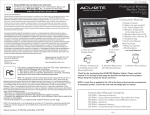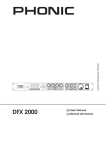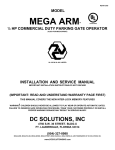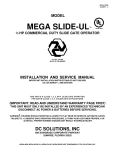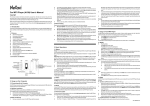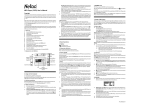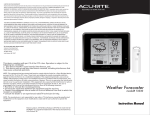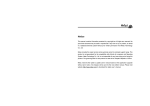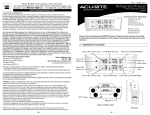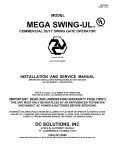Download Chaney Instrument 00825 Instruction manual
Transcript
INST - 00825 102308 Please DO NOT return product to the retail store. For technical assistance and product return information, please call Customer Care: 877-221-1252 Mon. - Fri. 8:00 A.M. to 4:45 P.M. (CST) Deluxe Weather Station Forecaster www.chaneyinstrument.com LIMITED ONE YEAR WARRANTY Chaney Instrument Company warrants that all products it manufactures to be of good material and workmanship and to be free of defects if properly installed and operated for a period of one year from date of purchase. REMEDY FOR BREACH OF THIS WARRANTY IS EXPRESSLY LIMITED TO REPAIR OR REPLACEMENT OF DEFECTIVE ITEMS. Any product which, under normal use and service, is proven to breach the warranty contained herein within ONE YEAR from date of sale will, upon examination by Chaney, and at its sole option, be repaired or replaced by Chaney. In all cases, transportation costs and charges for returned goods shall be paid for by the purchaser. Chaney hereby disclaims all responsibility for such transportation costs and charges. This warranty will not be breached, and Chaney will give no credit for products it manufactures which shall have received normal wear and tear, been damaged, tampered, abused, improperly installed, damaged in shipping, or repaired or altered by others than authorized representatives of Chaney. with wireless wind and temperature sensors #00825 DST OFF ON mph kph knots FUTURE FORECAST NW NE SW SE W E MIN THE ABOVE-DESCRIBED WARRANTY IS EXPRESSLY IN LIEU OF ALL OTHER WARRANTIES, EXPRESS OR IMPLIED, AND ALL OTHER WARRANTIES ARE HEREBY EXPRESSLY DISCLAIMED, INCLUDING WITHOUT LIMITATION THE IMPLIED WARRANTY OF MERCHANTABILITY AND THE IMPLIED WARRANTY OF FITNESS FOR A PARTICULAR PURPOSE. CHANEY EXPRESSLY DISCLAIMS ALL LIABILITY FOR SPECIAL, CONSEQUENTIAL OR INCIDENTAL DAMAGES, WHETHER ARISING IN TORT OR BY CONTRACT FROM ANY BREACH OF THIS WARRANTY. SOME STATES DO NOT ALLOW THE EXCLUSION OR LIMITATION OF INCIDENTAL OR CONSEQUENTIAL DAMAGES, SO THE ABOVE LIMITATION OR EXCLUSION MAY NOT APPLY TO YOU. CHANEY FURTHER DISCLAIMS ALL LIABILITY FROM PERSONAL INJURY RELATING TO ITS PRODUCTS TO THE EXTENT PERMITTED BY LAW. BY ACCEPTANCE OF ANY OF CHANEY’S EQUIPMENT OR PRODUCTS, THE PURCHASER ASSUMES ALL LIABILITY FOR THE CONSEQUENCES ARISING FROM THEIR USE OR MISUSE. NO PERSON, FIRM OR CORPORATION IS AUTHORIZED TO ASSUME FOR CHANEY ANY OTHER LIABILITY IN CONNECTION WITH THE SALE OF ITS PRODUCTS. FURTHERMORE, NO PERSON, FIRM OR CORPORATION IS AUTHORIZED TO MODIFY OR WAIVE THE TERMS OF THIS PARAGRAPH, AND THE PRECEDING PARAGRAPH, UNLESS DONE IN WRITING AND SIGNED BY A DULY AUTHORIZED AGENT OF CHANEY. THIS WARRANTY GIVES YOU SPECIFIC LEGAL RIGHTS, AND YOU MAY ALSO HAVE OTHER RIGHTS WHICH VARY FROM STATE TO STATE. For in-warranty repair, please contact: Customer Care Department Chaney Instrument Company 965 Wells Street Lake Geneva, WI 53147 Chaney Customer Care 877-221-1252 Mon-Fri 8:00 a.m. to 4:45 p.m. CST www.chaneyinstrument.com This device complies with part 15 of the FCC rules. Operation is subject to the following two conditions: 1- This device may NOT cause harmful interference, and 2- This device must accept any interference received, including interference that may cause undesired operation. WARNING: Changes or modifications to this unit not expressly approved by the party responsible for compliance could void the user’s authority to operate the equipment. NOTE: This equipment has been tested and found to comply with the limits for a Class B digital device, pursuant to Part 15 of the FCC rules. These limits are designed to provide reasonable protection against harmful interference in a residential installation. This equipment generates, uses and can radiate radio frequency energy and, if not installed and used in accordance with the instructions, may cause harmful interference to radio communications. However, There is no guarantee that interference will not occur in a particular installation. If this equipment does cause harmful interference to radio or television reception, which can be determined by turning the equipment off and on, the user is encouraged to try to correct the interference by one or more of the following measures: • Reorient or relocate the receiving antenna. • Increase the separation between the equipment and the receiver. • Connect the equipment into an outlet on a circuit different from that to which the receiver is connected. • Consult the dealer or an experienced radio/TV technician for help. TIMEZONE PST MST CST EST AM PM N WIND GUST S MAX MIN INDOOR MAX MIN OUTDOOR Instruction Manual Package Contents: (A) Main Unit with Display Stand (B) Wireless Temperature & Humidity Sensor (C) Wireless Wind Sensor (1) Hardware Bag (1) Instruction Manual MAX WIND SPEED PRESSURE InHg hPa HISTORY mph kph knots WIND CHILL HR. A. Main Unit with Display Stand What You Need: • Philips Screwdriver • (7) AA batteries -see “Install Batteries” B. Wireless Temperature & Humidity Sensor with Mounting Bracket C. Wireless Wind Sensor with Mounting Bracket Thank You for purchasing this ACURITE® Weather Station. Please read this manual in it’s entirety to fully enjoy the benefits and features of this product. Please keep this manual for future reference. NOTE: A clear film is applied to the LCD at the factory that must be removed prior to using this product. Locate the clear tab and simply peel to remove. Instruction Manual Contents SECTION 1- Overview of Features SECTION 2- Setup: Battery Installation, Basic Main Unit Setup SECTION 3- Placement of Main Unit and Wireless Sensors SECTION 4- Operation SECTION 5- Troubleshooting & Product Information NOTE: The manufacturer is not responsible for any radio or TV interference caused by unauthorized modifications to this equipment. Such modifications could void the user authority to operate the equipment. Patent numbers: 5,978,738; 6,076,044; 6,597,990 -1- SECTION 2 • SETUP SECTION 1 • OVERVIEW OF FEATURES Wind Gust DST OFF ON Barometric Pressure Wind Direction TIME ZONE PST MST CST EST AM PM N WIND GUST Future Weather Forecast A/B/C Wireless ID Selection Atomic Clock Month & Date mph kph knots FUTURE FORECAST NW MAX MIN INDOOR MAX MIN OUTDOOR Indoor Humidity Indoor Temperature NE W E SW Outdoor Temperature SE MIN S MAX WIND SPEED PRESSURE InHg HPa HISTORY mph kph knots Outdoor Humidity WIND CHILL HR. Barometric Pressure History Wind Speed Seasonal (wind chill) To allow for more than one weather station and wireless sensor network to be used in close proximity, the main unit and both wireless sensors have a small switch labeled “A B C” in the battery compartments. These switches are all factory preset into the same position (either A, B, or C). This switch selects one of 3 wireless modes to use, and all 3 switches in all 3 components MUST be set in matching positions (either A, B, or C) for wireless communication to take place successfully. See page 11 for more details. Install Batteries Batteries must be installed into all three of the wireless sensors BEFORE installing batteries into the main display unit. Use only fresh or new batteries in all cases, and install correctly according to the polarity ( - & + ) symbols marked on the batteries and in the battery compartments. We suggest using lithium batteries for better cold weather performance. Do not mix old and new batteries. Wireless Temperature & Humidity Sensor INSTALL BATTERIES: 1. Remove larger rounded solar shield. Wireless Temperature & Humidity Sensor Wireless Wind Sensor 2. Remove the battery compartment cover. Sends temperature and humidity information to the main unit via a 433 mhz wireless signal. This sensor should be mounted out of direct sunlight to ensure accurate readings. Powered by 2 “AA” batteries. Sends wind speed and direction to main unit via a 433 mhz wireless signal. This sensor should be mounted high enough to accurately record and transmit wind information. Powered by 2 “AA” batteries. 3. Install 2 “AA” batteries into the battery compartment. -2- INSTALL BATTERIES 4. Replace the compartment cover and replace the solar shield. REMOVE BATTERY DOOR -3- Wireless Wind Sensor SECTION 2 • SETUP INSTALL BATTERIES: Main Unit Startup 1. Unscrew and remove bottom case section. After batteries are installed in both wireless sensors and the main unit is powered up, the main unit will search for the wireless sensor signals. After the sensors signals are received, the main unit will search for the atomic clock signal. After the atomic clock signal is received, the time and date will be maintained automatically. This may take up to 24 hours and may not occur at all depending on your geographical location and your physical surroundings. See “troubleshooting” for atomic clock tips. INSTALL BATTERY 2. Remove the battery compartment cover.. INSTALL BATTERY 3. Install 2 “AA” batteries into the battery compartment. 4. Replace the battery compartment cover and replace and rotate the bottom cone section until it is securely tightened. REMOVE SLIDING BATTERY COMPARTMENT COVER UNSCREW BOTTOM CASING It is recommended that the time and date be manually set initially to ensure that they are accurate until the atomic clock signal is captured. The main unit will automatically exit out of SET MODE after a 10 second period of inactivity. INSTALL BATTERIES: + SET 3. Install 3 “AA” batteries into the battery compartment. Time & Date Setup To enter into SET MODE, press and hold the “SET” button for 3 seconds. Use the “-” and “+” buttons to adjust the selected preference, press the “SET” button again to confirm the adjustment and move on to the next preference. Main Unit 1. Remove the battery compartment cover. You may “force” the unit to search for the atomic clock at any time by pressing and holding the “-” button on the back of the main unit for 3 seconds. _ MIN MAX SCALE HISTORY 4. Replace the battery compartment cover. SET MODE in this order: 1. Time zone (Pacific, Mountain, Central, Eastern) 2. Daylight Saving Time (DST on or off) 3. Time (hour first, then minutes) 4. Year 5. Month 6. Date Scale Setup INSTALL 3 ” AA” BATTERIES -4- You may choose to display readings in U.S. or Metric scales (example ºF or ºC). To change the scale preferences, enter into scale set mode. REMOVE BATTERY COMPARTMENT COVER To enter into SCALE MODE, press the “SCALE” button. Use the “-” and “+” buttons to adjust the selected preference, press the “SCALE” button again to confirm the adjustment and move on to the next preference. -5- SECTION 3 • PLACEMENT Wireless Wind Sensor Now that setup is complete, you must choose a location to place the 3 wireless sensors and the main unit. The wireless sensors MUST be placed LESS THAN 100 feet away from the main unit. This wireless weather station uses radio frequency for communication, which is susceptible to interference from other electronic devices and large metallic items or thick walls. Always place both units at least 3 feet away from appliances ( TV, microwave, radios, etc. ) or objects ( large metal surfaces, thick stone walls, etc. ) that may interfere with the wireless communication. WIND (NO RTH ) NORTH PLACEMENT 1. Attach the wind sensor to the mounting bracket by simply sliding into the bracket. 2. The sensor must be mounted with the bracket pointing NORTH as indicated on the bracket and on the top surface of the wind sensor itself. The wireless wind sensor should be mounted high above all potential wind obstructions for maximum performance, keeping in mind it must remain within the 100 ft. wireless range of the main display unit. Attach to a solid surface utilizing screws and wall anchors (if applicable). Depending on the mounting surface, other steps may need to take place to ensure the sensor is mounted successfully. MAIN UNIT TEMP. & HUMIDITY Wireless Temperature & Humidity Sensor DST OFF ON TIMEZONE PST MST CST EST AM PM N WIND GUST mph kph knots FUTURE FORECAST NW MAX MIN INDOOR MAX MIN OUTDOOR NE W E SW SE MIN S MAX WIND SPEED PRESSURE InHg hPa HISTORY HR. mph kph knots WIND CHILL Placement of Main Unit PLACEMENT Place the main unit in a dry area free of dirt and dust. To help ensure an accurate indoor temperature measurement, be sure to place the main unit out of direct sunlight, and away from any heat sources or vents in your home. 1. Attach to a solid vertical OR horizontal surface out of direct sunlight for maximum performance. Attach the mounting bracket utilizing the included screws and wall anchors (if applicable). Depending on the mounting surface, other steps may need to be taken to ensure the sensor is mounted securely. There are 2 placement options for the main unit. You may hang the main unit on a wall using the integrated hang hole on the back. Alternatively, you may place the main unit on a table top or other flat surface utilizing the removable main unit display stand. Placement of Sensors The wireless sensors MUST BE PLACED OUTDOORS to observe outdoor weather conditions and relay them to the main unit display. The wireless sensors must be placed less than 100 feet from the main unit. -6- VERTICAL SURFACE HORIZONTAL SURFACE 2. Attach the temperature & humidity sensor to the mounting bracket by simply sliding into the bracket. -7- SECTION 4 • OPERATION A DAILY MINIMUM/MAXIMUM TEMPERATURE MEMORY DISPLAY: Press the MIN/MAX button once to view the MINIMUM recorded values for temperature, humidity and wind speed. Press the “MIN/MAX” button again to view the MAXIMUM recorded values for temperature, humidity and wind speed. While viewing the MINIMUM or MAXIMUM, press and hold the “MIN/MAX” button for 2 seconds to clear the currently viewed recorded values. mph kph knots E B PRESSURE HISTORY: C WEATHER FORECAST: ICONS SUNNY PARTLY COUDY W MOSTLY CLOUDY RAIN SNOW The forecast will likely show one of the above conditions most of the time, but will show a combonation when appropriate, and will show flashing icons when a storm is forecasted. D WEATHER FORECAST: 14 DAY LEARNING MODE This weather station has a patent pending fourteen day learning mode calibration process. During this learning mode the weather station will make altitude calculations that may affect the accuracy of the forecast. Once the 14 day learning mode process is complete, the learning mode icon will disappear and the weather forecast should be ready for superior operation. You can track the progress of the learning mode by viewing the progress bar located beside the future forecast weather icon display area. E WIRELESS SIGNAL: RECEPTION ICONS The main unit has signal reception icons in the outdoor sensor display areas and near the atomic clock display. If there are a low number of “bars” present, you may experience no temperature display ( “--” ) or inaccuracy. See the troubleshooting section for more tips on wireless signal reception for the sensors and for the atomic clock signal. -8- InHg hPa INDOOR E A MAX MIN OUTDOOR SE S A MIN D F A MAX NE SW PRESSURE TIMEZONE PST MST CST EST E MIN NW C This feature gives you the predicted weather forecast for the next 12 to 24 hours based on an advanced algorithm that includes barometric pressure system and temperature tracking. This weather station will provide the most accurate forecast that a single station weather instrument can provide. AM PM N WIND GUST FUTURE FORECAST Also available to you is the option to go back through the last 12 hours of pressure readings. Press the “HISTORY” button repeatedly to go through the barometric pressure history. You must have at least 1 hour of pressure records to go back through pressure history. WHen the pressure history reads “-0”, the current pressure is being displayed. H DST OFF ON MAX E H F WIND SPEED mph kph knots HISTORY HR. WIND CHILL H B G F F TREND INDICATOR ICONS: Trend arrow icons will display next to the outdoor temperature and humidity display as well as next to the (barometric) pressure display. These arrows will show at a glance if these values are falling, steady or rising. G WIND CHILL: When the outdoor temperature falls below 40ºF, the wind chill will be automatically calculated and displayed. The wind chill display will show no reading until a wind chill reading is relevant, based on current conditions. H LOW BATTERY INDICATORS: When the batteries in the main display unit or in the outdoor sensors are low, the low battery icon will display. For the main display unit, the low battery icon will display next to the time. For the outdoor temperature and humidity sensor, the low battery icon will display next to the outdoor temperature. For the wind sensor, the low battery icon will display next to the wind speed. When batteries need to be replaced, follow the instructions in section 2. It may take some time for the sensors to reconnect with the main unit after batteries are replaced. -9- SECTION 5 • TROUBLESHOOTING and PRODUCT INFORMATION Set Wireless ID WIreless RF technology is subject to interference from many sources, as mandated by the FCC. Occasionally, there will be temporary disconnection to the wireless sensor. This device is designed to search and acquire the signal again if there is interference or temporary loss of signal. In most cases, the temperature will show again if the main unit and wireless temperature sensor are able to re-connect automatically. If the disconnection lasts longer than a few hours, refer to this troubleshooting guide. MIN MAX + SCALE SET _ HISTORY Troubleshooting Problem Bad Wireless Sensor Reception no bars Bad Atomic Clock Reception no bars No Wireless Sensor Data (no communication) no bars and flashing “ -- ” data Main Unit Display Not Working Possible Solution REMOVE BATTERY COMPARTMENT COVER Relocate the main unit and/or the wireless sensors. All units must be within 100 feet from each other. Make sure both units are placed at least 3 feet from other electronic appliances and devices that may interfere with the wireless communication (such as TV’s, microwaves, computers etc). NOTE: It may take up to 20 minutes for the main unit to re-synchronize with the sensors when batteries are replaced. Use lithium batteries in sensors when temperature is below -4ºF. Relocate the main unit. It is important that the atomic clock sensor (located in the wireless temperature/humidity sensor) is located in an area clear of any large stone or metallic surfaces. Make sure the main unit is placed at least 3 feet from other electronic appliances and devices that may interfere with the wireless communication (such as TV’s, microwaves, computers etc). Large metallic surfaces will also interfere with the atomic clock signal. If wireless reception is bad (no bars), see “Bad Reception” section above. The wireless ID setting on each unit must match for all units to communicate properly. See “Set Wireless ID” on the next page. Make certain that the batteries are installed correctly. The batteries may need replacing. If you are using the AC power adaptor, make certain it is plugged in and the outlet power is switched on. - 10 - AB C All wireless ID’s must match ABC This wireless weather station uses long range 433mhz radio frequency for communication. In the event that you have reception problems due to interference, both the main unit and both wireless sensors have a selectable wireless ID. The ID switches are located within the battery compartments of the main unit and the wind sensor. The switch is located near the battery compartment cover on the temperature sensor. You may choose A, B or C; but both the main units and the wireless sensors ID's must match for successful synchronization. 40 Extended periods of cold temperatures ( below -4ºF / -20ºC ) can cause alkaline batteries to function improperly. This will cause the outdoor wireless sensor to stop transmitting temperature readings. Use lithium batteries in these low temperature conditions to ensure continued operation for wireless sensors placed outdoors. - 11 - About the Atomic Clock A clock is considered atomic if it has an accuracy of one second in a million years. Consumer clocks are considered atomic if they attain this accuracy by receiving a signal from an atomic clock. In North America, the National Institute of Standards and Technologies operates an atomic clock in Colorado which transmits the time codes via the radio station WWVB. The signal is transmitted in a very low frequency (60,000 Hz). The Acurite clock you have purchased includes a built-in receiver which picks up the signal from the WWVB station. NOTE: Due to solar radiation in the atmosphere, the atomic clock signal is weak during the day. Most synchronization with the WWVB atomic clock signal happens at night when there is less interference. Measurement Ranges Temperature Main Unit Temperature: 32ºF to 122ºF / 0ºC to 50ºC Wireless Sensors: temperature sensor: -40ºF to 158ºF / -40ºC to 70ºC humidity sensor: 16% RH to 99% RH wind sensor: up to 99 mph / 159 Kph (depending on conditions) Specifications Power Requirements Main Unit: 3 x “AA” alkaline batteries Wireless Sensors: temperature & humidity sensor: 2 x “AA” alkaline or lithium (recommended) batteries wind sensor: 2 x “AA” alkaline or lithium (recommended) batteries Wireless Communication Radio Frequency: 433 mhz Transmission Intervals: every 16 seconds Atomic Clock Frequency: WWVB 60Khz Synchronizes Daily ALWAYS USE PROPER TOOLS AND MOUNT/PLACE SENSORS IN AREAS THAT WILL BE SAFE TO YOURSELF AND OTHERS. SEEK PROFESSIONAL ASSISTANCE IN MOUNTING/PLACING THE WIRELESS SENSORS AND FOLLOW YOUR LOCAL LAWS AND REGULATIONS WHEN CHOOSING A MOUNTING/PLACEMENT LOCATION FOR THE WIRELESS SENSORS PLEASE DISPOSE OF OLD OR DEFECTIVE BATTERIES IN AN ENVIRONMENTALLY SAFE WAY AND IN ACCORDANCE WITH YOUR LOCAL LAWS AND REGULATIONS. BATTERY SAFETY: Follow the polarity (+/-) diagram in the battery compartment. Promptly remove dead batteries from the device. Dispose of used batteries properly. Only batteries of the same or equivalent type as recommended are to be used. DO NOT incinerate used batteries. DO NOT dispose of batteries in fire, as batteries may explode or leak. DO NOT mix old and new batteries or types of batteries (alkaline/standard). DO NOT use rechargeable batteries. DO NOT recharge non-rechargeable batteries. DO NOT short-circuit the supply terminals. Product Registration To receive product information, register your product online. It’s quick and easy! Log on to http://www.chaneyinstrument.com/product_reg.htm - 12 - - 13 -














